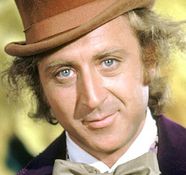
 Gene Wilder was a beloved American stage, screen and TV actor who made people laugh just by being himself. He was also a successful screenwriter, film director and author. He is best remembered for the movies where he appeared to be naive and childlike: Willy Wonka & the Chocolate Factory, Young Frankenstein, Blazing Saddles, Silver Streak, The Adventure of Sherlock Holmes' Smarter Brother, Everything You Always Wanted to Know About Sex* (*But Were Afraid to Ask), The World's Greatest Lover, Hanky Panky, Haunted Honeymoon, See No Evil, Hear No Evil and more.
Gene Wilder was a beloved American stage, screen and TV actor who made people laugh just by being himself. He was also a successful screenwriter, film director and author. He is best remembered for the movies where he appeared to be naive and childlike: Willy Wonka & the Chocolate Factory, Young Frankenstein, Blazing Saddles, Silver Streak, The Adventure of Sherlock Holmes' Smarter Brother, Everything You Always Wanted to Know About Sex* (*But Were Afraid to Ask), The World's Greatest Lover, Hanky Panky, Haunted Honeymoon, See No Evil, Hear No Evil and more.
Wilder directed in The Adventures of Sherlock Holmes’ Smarter Brother in 1975. He wrote the script and starred in The World’s Greatest Lover in 1977, the Woman In Red in 1984 and Haunted Honeymoon in 1986.
Gilda Radner's Ovarian Cancer
The couple wanted to have children, but she suffered miscarriages. In 1986, she went to a doctor to find out why she could not sustain a pregnancy. Her only symptoms were that she felt weak and tired, would fall asleep during the day and had pain in her upper legs. Doctors told her that she had Epstein Barr, the virus that causes mononucleosis. After ten months of incorrect diagnoses, she was finally diagnosed with Stage IV ovarian cancer that had already spread through her body. For the next year and a half, she was treated with chemotherapy and radiotherapy, and doctors told her that her cancer was in remission. In 1989, the cancer was found to have metastasized through her body and she died on May 20, 1989. In her memory, he helped found an ovarian cancer detection center in her name in Los Angeles. Even today, with the best of treatments available, fewer than 20 percent of ovarian cancer patients survive for five years.